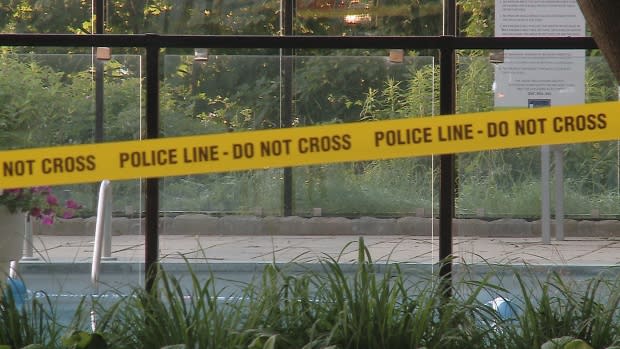Recent drowning deaths prompt officials to talk about water safety
A string of drownings in Ontario in recent days — including the death of a mother trying to save her young son — is prompting officials to remind people to take a few moments to think about safety.
"When I look at these drownings every year, and I've been doing this for over 20 years, I think almost all of them are preventable," said Barbara Byers, public education and research director for Lifesaving Society Ontario, a charitable organization that works to prevent drownings.
Experts like Byers are telling swimmers and boaters to wear a lifejacket, swim with a buddy, know your limits and enter shallow areas first before venturing into deeper waters. Jump in instead of diving, if the waters are unfamiliar.
They say, take stock of your abilities before swimming far out in a lake. Remember that inflatable devices, such as unicorns, are "play toys" and won't safe your life.
Put lifejackets on young children and control and restrict access to water, experts add. They say keep children within arm's reach. Watch them, not your phone, they say. If you need to rescue them, do what lifeguards do and bring along a piece of lifesaving equipment, such a lifejacket or a noodle.
Forty-three people have drowned in Ontario this year from Jan. 1 to July 15. Fifteen of the deaths occurred in the first two weeks of July.
12 people in Ontario drowned while swimming this year
The total number is a slight decrease from the same time period last year, when 48 people had drowned. Of the numbers this year, 12 drowned while swimming, 11 while boating, seven fell into the water unexpectedly, 10 died through land, ice or air transportation, such as a car plunging into water. Circumstances surrounding three deaths were unknown.
Eight out of 43 were children under 19 years of age. Other age groups that accounted for many of the drowning deaths, include young adult men in their 20s and 30s, and adults aged 55 and over.

In drowning cases involving older adults, often they are swimming alone and are less resilient when faced with challenging conditions, Byers added.
"We really can prevent most drownings ... if we take a few moments to be aware of our own abilities, to be very respectful of the water and to take some precautions to keep ourselves and our families safe," she said.
Byers said the peak season for drowning in Ontario occurs in the last two weeks of July and the first two weeks of August. She said the slightly lower numbers for this year are likely due to the long, cold winter, the cool spring and high water levels.
"People delayed the start of their recreationally time around the water," she said.

She said Ontario residents drown in lakes, rivers and streams as well as private and public swimming pools. In winter, they drown when snowmobiles fall through ice. In all seasons, they can drown when they panic.
"When a person is drowning, their airway fills with water and they can't speak and they can't breathe," she said. "It's silent. It's fast."
Oshawa woman died while trying to save son on lake
On Sunday, an Oshawa woman, 33, drowned in Pickering, Ont. after she tried to save her son, aged 6, as the wind carried his inflatable device farther out on Lake Ontario.
The child was rescued and is reported to be fine, but the woman was unable to swim back. Bystanders brought her to shore and administered CPR along with police until paramedics arrived.

She was pronounced dead in hospital.
"It was windy," Dave Selby, spokesperson for Durham Regional Police Service, told CBC Toronto on Monday. "This is a good example of how things can change quickly."
Byers said anyone trying to rescue someone should remember what lifeguards do.
"They take something with them," she said. "If you are going out to rescue them, you have something to hold onto." A noodle, an inflatable device, even a cooler lid that floats, would help, she added.
OPP probing weekend drownings
Sgt. Jason Folz, media relations co-ordinator for Ontario Provincial Police's Central Region, said police are investigating the following weekend drownings:
On Sunday, Ryan Taylor, 20, of Whitchurch-Stouffville, died in hospital after he and three friends jumped off a dock in Cavendish Lake in the Municipality of Trent Lakes.
On Saturday, Kathy Venneman, 53, of Erin, Ont., went swimming with a group of friends in the Trent-Severn waterway near Morrison Landing when she failed to surface. She was found dead the following day.
"What we are telling people and encouraging people, if they have proper-fitting lifejackets, is to wear them. If you're not a very strong swimmer, there's no shame in wearing one," Folz said on Monday.

"The vast majority of people who drown in the province of Ontario are not wearing an approved life jacket," he said.
Six of the Ontario drownings this year involved private pools. Some of them were in the Greater Toronto Area:
Last Wednesday, a woman, 79, and her grand-daughter, 4, were found face down in a pool at an Oakville, Ont. home. The grandmother was pronounced dead at the scene. The girl regained consciousness before police arrived. She is listed in critical condition.
On Monday, the body of a man, 89, was pulled from a pool at a high-rise apartment building in Burlington, Ont.
About 100 people drowned in Ontario last year. About 400 people drown every year in Canada.

